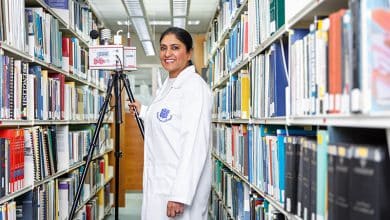Entesar Al-Hetlani Analytical Chemistry Makes Every Drop Count

Entesar Al-Hetlani is pioneering
analytical chemistry in Kuwait, realizing
the goals she dreamed of as a student. “I
used to watch all these TV shows where
they would solve crimes,” said Al-Hetlani,
who is now an analytical chemist at
Kuwait University.
“I’d see them using the same
instruments we had in our lab. I know
they weren’t realistic, but there was
something very attractive about it. I saw
chemistry being used for something real
and relevant, and I just wanted to do
that.” Al-Hetlani became interested in
analytical chemistry at the University of
Hull, England, where she went on a
scholarship as a graduate student, and
the program they offered was analytical
chemistry. “I found it really fascinating. If
you can analyze something to determine
what’s in it and how much, then you can
answer so many questions,” the winner
of the Jaber Al-Ahmad Award for Young
Researchers 2020 from the Kuwait
Foundation for the Advancement of
Sciences (KFAS) said.
Her interest is partly driven by the
challenge of solving puzzles. Comparing
scientific research to solving a crime,
Al-Hetlani said, “you have several clues
and all of them are important, but it’s up
to you to decide which ones are more
important.” Chemical analysis can help
by wringing as much information as
possible from each clue. For example,
fingerprints have been a staple of
sleuthing for over a century, but experts
like Al-Hetlani can glean so much more
from them than we could before.
Al-Hetlani said that fingerprints are
“more than just an impression,” and
analyzing them in different ways can
provide information about a person’s
ethnicity or gender, as well as other
details. Some of her research, which was
funded by KFAS, has focused on
improving our ability to use fingerprints
to learn not about who a person is, but
rather, what they were handling.
Detecting and identifying traces of
drugs from fingerprints could be
immensely useful to determine what
happened at a crime scene, especially as
Kuwait faces a growing drug problem.
Al-Hetlani accomplishes this by
adjusting a technique known as SALDI,
in which a sample is ionized by a laser,
and the ionized molecules are then
identified by mass spectrometry, a highly
discriminating technique. Al-Hetlani
wondered whether this method could be
improved by dusting the fingerprints with
metal oxide nanoparticles. When they
tested the idea, Al-Hetlani’s team found
that it reduced background noise that
could obscure the analysis. The
researchers were able to reliably detect
traces of drugs on fingerprints after a
week, as long as the samples were stored
at low or moderate temperatures.
Now her team is working to squeeze
even more information out of
fingerprints; one student is working to
identify traces of cosmetics in
fingerprints, perhaps even pinpointing
the specific brand, while another is trying
to detect more information about
‘endogenous characteristics’— features of
the person who left the print. Al-Hetlani
also worked out how to learn something
about a person from a small sample of
saliva. She took a sabbatical in Igor
Lednev’s lab at the University at Albany,
State University of New York, to learn a
technique known as Raman
spectroscopy. In Raman spectroscopy, a
sample is illuminated with a laser, and
changes in the energy of scattered
photons are used to determine the
molecular composition of the sample.
Lednev was impressed with Al-Hetlani
and said, “We immediately recognized
that she had an excellent background
and strong expertise in spectroscopy
and spectrometry. She did excellent
research in my lab, and we published a
joint paper in the top journal in the
field.”
The paper, which made the cover
of that issue, was about figuring out
whether a saliva trace came from a
smoker. By training a machine learning
system on Raman spectra from smokers
and non-smokers, they developed a
model that could accurately pinpoint
where a sample had come from. “This
could be very helpful for law
enforcement agencies, especially at the
beginning of an investigation, because it
would give them additional information
about potential suspects,” said Lednev. Handheld Raman spectrometers are
available, meaning the analysis could be
run directly at the crime scene. While on
her sabbatical, Al-Hetlani also
developed an improved method to
diagnose celiac disease.
Lednev’s team could already use
Raman spectroscopy to diagnose celiac
disease on the basis of a blood sample,
but their approach required statistical
analysis to detect the tiny changes in the Raman spectrum. By adjusting the
wavelength of the lasers used, Al- Hetlani found conditions that produce spectra that were much easier to analyze. “Now, the differences are very significant. You can see them with the naked eye,” said Lednev. The findings are exciting, but Lednev notes that they
need to be validated with a larger sample
set and then published. “We’re even considering patenting it,” he said.
The underlying theme in much of Al-
Hetlani’s work has been getting as much as possible out of limited material.
That’s certainly true of another
contribution she has made to tackling
drug abuse. Using the same techniques
as they had for fingerprint analysis,
Al-Hetlani and her team were able to determine whether a drink had been
spiked from just a few millionths of a
liter—less than a drop.
Drug analysis has always been important to Al-Hetlani. “I think it’s a problem now. It was a
problem in the past, and it will always be
a problem that will only get worse with
time,” she said. “If we have people who
can work on this and keep up with the
changes by using technology, then
maybe we can contain the situation.”
Getting as much as possible out of every
clue is vital in forensics, where material
is both limited and irreplaceable. The
other significant advantage of the
techniques Al-Hetlani is developing is
their speed. She says that forensics
experts in Kuwait are overwhelmed by
their caseload, so every boost in speed
Raman spectrum. By adjusting the
wavelength of the lasers used, Al-
Hetlani found conditions that produce
spectra that were much easier to
analyze. “Now, the differences are very
significant. You can see them with the
naked eye,” said Lednev. The findings
are exciting, but Lednev notes that they
need to be validated with a larger sample
set and then published. “We’re even
considering patenting it,” he said. The
underlying theme in much of Al-
Hetlani’s work has been getting as much
as possible out of limited material.
That’s certainly true of another
contribution she has made to tackling
drug abuse. Using the same techniques
as they had for fingerprint analysis,
Al-Hetlani and her team were able to
and efficiency helps. In the long run, she
hopes a collaborative center between
Kuwait University and the Ministry of
Interior can bring together researchers
and forensics experts to push analyses
forward and discover new applications.




